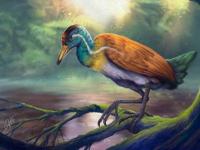Pterosaurs were Capable of Flapping Flight during Earliest Phases of Life, Study Suggests

The humerus bones of the newly-hatched pterosaurs were stronger than those of adults pterosaurs, indicating that they would have been strong enough for flight, according to new research led by Dr. Darren Naish, a paleontologist in the School of Biological Sciences at the University of Southampton.
“There have been several debates about whether juvenile pterosaurs could fly, but this is the first time it’s been studied through a more biomechanical point of view,” said senior author Dr. Elizabeth Martin-Silverstone, a paleontologist in the School of Earth Sciences at the University of Bristol.
“It’s exciting to discover that even though their wings may have been small, they were built in a way that made them strong enough to fly.”
In the study, Dr. Naish, Dr. Martin-Silverstone and their colleague, Dr. Mark Witton from the School of the Environment, Geography and Geosciences at the University of Portsmouth, modeled the flying abilities of newly-hatched pterosaurs.
They used previously obtained wing measurements from four established hatchling and embryo fossils from two species of Cretaceous-period pterosaurs: Pterodaustro guinazui and Sinopterus dongi.
The paleontologists also compared these wing measurements with those of adults from the same species and compared the strength of the humerus bone, which forms part of the wing, of three hatchlings with those of 22 adult pterosaurs.
They found that hatchling humerus bones were stronger than those of many adult pterosaurs, indicating that they would have been strong enough for flight.
“We found that these tiny animals — with 25 cm (10 inches) wingspans and bodies that could neatly fit in your hand — were very strong, capable fliers,” Dr. Witton said.
“Their bones were strong enough to sustain flapping and take-off, and their wings were ideally shaped for powered — as opposed to gliding — flight.”
“However, they would not have flown exactly like their parents simply because they were so much smaller: flight capabilities are strongly influenced by size and mass, and so pterosaur hatchlings, being hundreds of times smaller than their parents, were likely slower, more agile fliers than the wide-ranging, but less manoeuvrable adults.”
The researchers also found that while hatchlings had long, narrow wings suited to long-distance flight, their wings were shorter and broader than those of adult pterosaurs, with a larger wing area relative to hatchling mass and body size.
These wing dimensions may have made hatchlings less efficient than adult pterosaurs at long-distance travel, but may have resulted in them being more agile fliers, enabling them to suddenly change direction and speed.
“The agile flying style of hatchling pterosaurs may have enabled them to rapidly escape predators and made them better suited to chasing nimbler prey and flying amongst dense vegetation than adult pterosaurs,” the scientists said.
The study was published in the journal Scientific Reports.
_____
D. Naish et al. 2021. Powered flight in hatchling pterosaurs: evidence from wing form and bone strength. Sci Rep 11, 13130; doi: 10.1038/s41598-021-92499-z
Source: www.sci-news.com/








